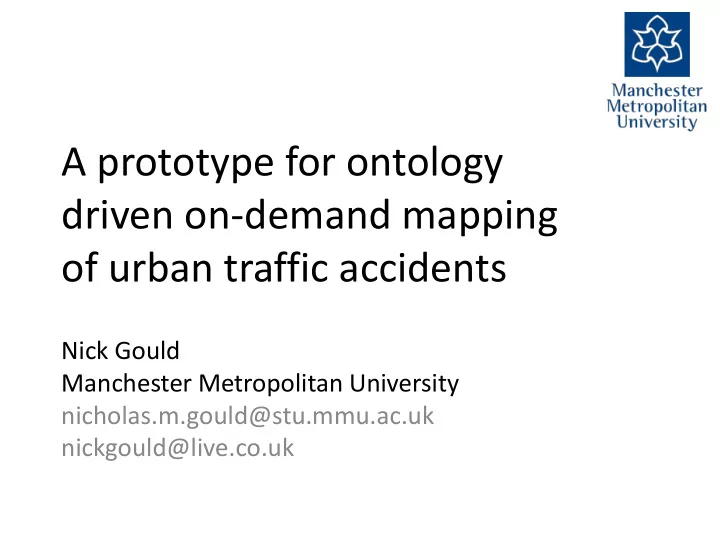

A prototype for ontology driven on-demand mapping of urban traffic accidents Nick Gould Manchester Metropolitan University nicholas.m.gould@stu.mmu.ac.uk nickgould@live.co.uk
Project context NMA map production On-demand mapping Google Maps Highly automated Multiple scales Unfamiliar data Fixed target scales Base maps Automatic generalisation User data overlays Familiar features Integrate not overlay No integration Sophisticated software Non-expert Non-expert Experts
Use case: mapping road accidents
Respecting relations
Conceptual framework Digital Generalisation Philosophical Objectives Cartometric Evaluation Spatial and Attribute transformations ( When to generalise) ( Why to generalise) ( How to generalise) Theoretical Geometric Spatial elements Conditions transformations reducing complexity congestion simplification maintaining spatial accuracy coalescence smoothing aggregation maintaining attribute accuracy conflict maintaining aesthetic quality complication amalgamation Describe these maintaining a logical hierarchy inconsistency merging concepts in an consistently applying rules imperceptibility collapse refinement ontology Application-specific Spatial and elements holistic measures exaggeration enhancement density measures map purpose and intended scale displacement distribution measures appropriateness of scale length & sinuosity measures retention of clarity Attribute shape measures Transformations Computational distance measures elements classification Gestalt measures symbolisation cost effective algorithms abstract measures Transformation maximum data reduction controls minimum memory/disk requirements generalisation operator selection algorithm selection parameter selection McMaster & Shea, 1992
Question • Can the concepts of cartographic generalisation be formalised in an ontology with sufficient detail to allow the process to be automated?
Ontological concepts: general Operation hasEffect implements “is a” relationship Remedy Transformation Algorithm relieves Property relationship Symptom Algorithm hasSymptom measures FeatureCollection Measure Algorithm Problem FeatureCollection
Ontological concepts: particular hasEffect Amalgamation implements Amalgamation FeatureCount hasEffect Algorithm Reduction SelectionBy relieves Attribute implements Property relationship HighFeature SelectionByAttribute Density Algorithm hasSymptom measures PointFeature CongestedFeature Density Collection MeasureAlgorithm
System overview Why, When, How Represents Implements Uses Mapping Ontology Engine
System architecture Java application Protégé Ontology Copy of OWL Java API editor (OWL file) Ontology Source data Results Mapping Engine (Shape files) (Shape files) Measure Transformation Algorithms Algorithms GeoTools On-demand mapping system
Process
Degree Of Generalisation The ontology identifies transformation (generalisation) algorithm… but… • … how to automatically provide parameter values for the algorithm? • Measure Algorithm Number of problem features DegreeOfGeneralisation 1...9 Transformation Algorithm
Transformation algorithm: pruning Total length = 335413m DegreeOfGeneralisation = 9 Target length = 33541 m Current length = 5710m 33600m 9257m 14240m
Source data Road network and accidents at 1:30K
Conditions: accidents High road accident density Identified by measure algorithm
Conditions: roads High (cross)road density Identified by measure algorithm
Workflow A Collapse roads Amalgamate accidents Prune roads B
Results Pruned road network and amalgamated accidents at 1:30K
Missing context • Road sections that provide context have been pruned
Spatial relations • Semantics – what is a road accident? – Punctual event – Takes place on a road • Expressed as spatial relation contained by adjacent intersects intersects
Modelling spatial relations SpatialRelation intersects intersects “Is A” relationship Intersects measuredBy IntersectMeasure Algorithm AccidentIntersects Road hasThematicFeatureType hasSupportFeatureType Accident Road hasSupportGeometry FeatureType FeatureType hasThematicGeometry hasSupportGeometry Goal: store knowledge in the ontology and AreaGeometry AreaGeometry not the algorithm LineGeometry
Workflow – accidents only For a particular condition OR = user selection A at a particular scale OR Amalgamate SelectByAttribute accidents accidents OR Amalgamate SelectByAttribute Amalgamate accident accidents accidents clusters • Non-deterministic workflow • Apply optimisation method? • Refine the ontology….?
Refining the ontology Describing the impact of operations Change in geometry Collapse Amalgamation Simplification Change in abstraction • Can impact be linked to user requirements?
Conclusion • Difficulties building workflow with ontologies • Role for ontologies in on-demand mapping? • Support for agent-based systems? – Provide shared knowledge base – Make implicit ontologies explicit
Future work? - Web Ontology Services for generalisation Web Ontology Service Generalisation Data Ontology Ontology Semantic injection Data Processing Services Services WEBGEN Web Reasoning Service
Thank you! • Thanks to: – OSGB – Nico Regnauld – William Mackaness – Transport for Greater Manchester
Recommend
More recommend